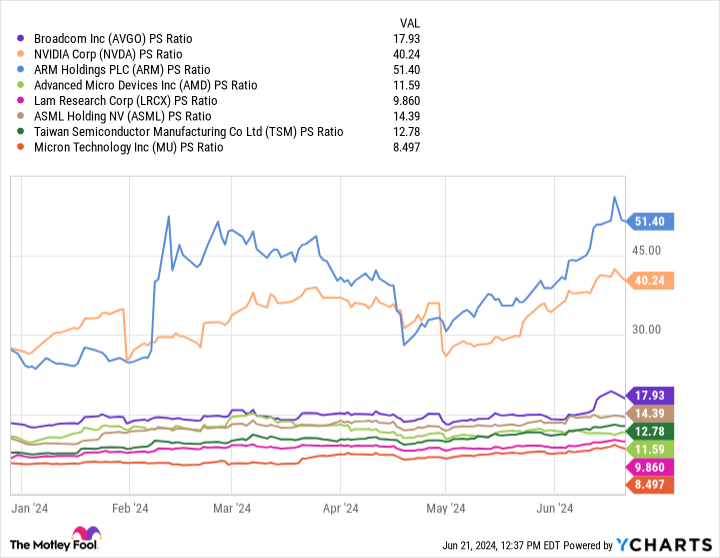The stock market is off to a torrid start to 2024. Around the middle of the year, the S&P500 gained around 15% while the technology sector Nasdaq Composite is up nearly 18%.
One of the hottest sectors driving the market to new heights is technology, primarily driven by the euphoria surrounding all things artificial intelligence (AI). As stock prices continue to climb, some companies have resorted to stock splits in an effort to open up their shares to a broader base of investors.
Semiconductor company Broadcom (NASDAQ:AVGO) is the most recent chip company to announce a stock split, joining its peers Nvidia And Search Lam.
Let’s look at some important details about the stock split and assess whether Broadcom could be a lucrative opportunity for long-term investors.
1. What are stock splits and how do they work?
A stock split is a financial engineering instrument in which the price and number of shares of a company change based on the split factor.
In early June, Broadcom announced that it would conduct a 10-for-1 stock split. This means that after the split, Broadcom’s outstanding shares will increase 10 times while its stock price will fall 10 times.
Let’s take a look at an example. In the table below, you can see Broadcom’s current share count, stock price, and market capitalization before and after the split.
|
Article |
Pre-separation |
Post-split |
|---|---|---|
|
Number of shares |
465 million |
4.6 billion |
|
Stock price |
$1,698 |
$169 |
|
Market capitalization |
790 billion dollars |
790 billion dollars |
Data source: Broadcom SEC filings and Yahoo! Finance.
If the split were to take place today, Broadcom’s number of outstanding shares would fall from approximately 465 million to 4.6 billion. At the same time, the company’s stock price would be reduced by a factor of 10, from $1,698 to $169. Given this dynamic, investors may find that a stock split does not change a company’s market capitalization.


2. Why might Broadcom split its shares?
AI has been one of the biggest drivers for financial markets over the past 18 months. Chip stocks in particular have benefited greatly from the hype around AI.
Since January 2023, Broadcom shares have soared 204%. As of this writing, Broadcom stock is hovering around $1,700, near its 52-week high of $1,851.
Given that the stock is trading at record highs and boasting a four-digit price tag, many investors likely view Broadcom as expensive. However, this way of thinking is not entirely correct and may actually prevent retail investors from missing out on good opportunities.
What I mean by this is that investors shouldn’t base their decision to buy a stock solely on its price. A thorough analysis of valuation multiples and comparison of the company against a set of peers is necessary to determine whether a stock may be overvalued or undervalued.
3. How are stock splits handled?
The advantage of stock splits is that they are handled quite transparently. If you currently own Broadcom stock, your investment broker will manage all the mechanics in the background.
For example, let’s say you currently own 10 shares of Broadcom at an average price of $1,500. Provided you do not buy or sell additional shares before the split, your account will automatically reflect 100 shares held at an average price of $150 once the split is complete.
4. Has Broadcom ever split its shares?
Broadcom first went public in 1998 and traded under the symbol BRCM on the Nasdaq stock exchange. During its trading under the symbol BRCM, Broadcom completed three stock splits.
However, in 2016, Avago Technologies acquired Broadcom for $37 billion.. As part of the transaction, Avago Technologies changed its name to Broadcom Inc. The stock symbol BRCM was retired and Broadcom now trades on Nasdaq under the symbol AVGO.
Since trading under its new ticker under Avago Technologies since 2016, Broadcom has not split its shares.
5. Is Broadcom stock a buy right now?
Valuing semiconductor stocks can be a bit of a daunting exercise. The chip industry is highly cyclical, and right now, companies across the board are facing outsized demand in the wake of the AI revolution.
Given the nature of the chip industry, metrics like profits and cash flow can deteriorate quickly. For this reason, using the price-to-earnings (P/E) ratio or the price-to-free cash flow (P/FCF) multiple is not very useful, as each can be inconsistent over long time ranges. term.


Using analysis of the chart above, investors can see that Broadcom’s price-to-sales (P/S) multiple of 17.9 falls squarely in the middle of this set of peers. That said, Nvidia and Arm holds are obvious outliers among this cohort. Excluding those two, Broadcom would be valued at a premium over most of its chip peers.
Despite its high valuation, I don’t recommend waiting until after the split to pick up shares. As explained above, the lower price of Broadcom shares after the split does not mean that they are actually cheaper.
Additionally, stock splits usually attract a lot of attention. Split stocks may experience some volatility and momentum at the time of the split, thus pushing the stock price higher after the split. If this happens, it technically means you’re buying Broadcom stock at a higher valuation than before the split.
For me, investing in Broadcom must be rooted in a long-term conviction around AI and the company’s ability to emerge as a leader. If you’re looking to hedge other chip stocks in your portfolio or gain exposure to long-term AI tailwinds, Broadcom could be a good opportunity right now.
Should you invest $1,000 in Broadcom right now?
Before buying Broadcom stock, consider this:
THE Motley Fool Stock Advisor The analyst team has just identified what they think is the 10 best stocks for investors to buy now…and Broadcom wasn’t one of them. The 10 selected stocks could produce monster returns in the years to come.
Consider when Nvidia made this list on April 15, 2005…if you had invested $1,000 at the time of our recommendation, you would have $775,568!*
Equity Advisor provides investors with an easy-to-follow plan for success, including portfolio building advice, regular analyst updates, and two new stock picks each month. THE Equity Advisor the service has more than quadrupled the return of the S&P 500 since 2002*.
See the 10 values »
*Stock Advisor returns June 24, 2024
Adam Spatacco holds positions at Nvidia. The Motley Fool holds positions and recommends ASML, Advanced Micro Devices, Lam Research, Nvidia and Taiwan Semiconductor Manufacturing. The Motley Fool recommends Broadcom. The Motley Fool has a disclosure policy.
Here are 5 things smart investors should know about Broadcom’s upcoming 10-for-1 stock split, originally published by The Motley Fool